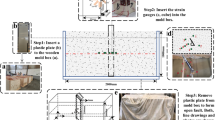Some fault areas respond with stable, quasi-static motion, with slip rates comparable to tectonic rates of millimeters to tens of millimeters per year, inducing deformation development of rock mass in active fault zones. Herein, a mechanical model of fault creep was established considering that the displacement pattern is subject to the static displacement of the fault rupture based on the fault characteristics and geological conditions, and a function of different critical parameters was proposed and evaluated. Displacement distribution patterns were identified by the in situ stress, mechanical parameters of the rock mass in the fault zone, the coefficient friction of contact surfaces between the fault core and damage zone, and fault inclination angle. The higher the horizontal extrusion degree and the softer the rock mass of the fault core are, the higher the degree of displacement concentration in the fault core.
Similar content being viewed by others
References
Anastasopoulos and G. Gazetas, “Foundation–structure systems over a rupturing normal fault: Part I. Observations after the Kocaeli 1999 earthquake,” Bull. Earthq. Eng., 5(3), 253-275 (2007).
M. Bayati and J. Khademi Hamidi, “A case study on TBM tunnelling in fault zones and lessons learned from ground improvement,” Tunn. Undergr. Space Technol, 63(162-170 (2017).
Y. Ben-Zion and C. G. Sammis, “Characterization of Fault Zones,” Pure Appl. Geophys., 160(3-4), 677-715 (2003).
R. A. Harris, “Large earthquakes and creeping faults,” Rev. Geophys., 55(1), 169-198 (2017).
N. M. Newmark and W. J. Hall, “Pipeline design to resist large fault displacement,” Proc. of the U.S. National Conference on Earthquake Engineering, Michigan, USA, (1975).
V. Trifonov and V. P. Cherniy, “Elastoplastic stress–strain analysis of buried steel pipelines subjected to fault displacements with account for service loads,” Soil. Dyn. Earthq. Eng., 33(1), 54-62 (2012).
R. L. Wang and Y.-H. Yeh, “A refined seismic analysis and design of buried pipeline for fault movement,” Earthq. Eng. Struct. Dyn., 13(1), 75-96 (2010).
M. Ashtiani, A. Ghalandarzadeh, and I. Towhata, “Centrifuge modeling of shallow embedded foundations subjected to reverse fault rupture,” Can. Geotech. J., 53(3), 505-519 (2015).
M. H. Baziar, A. Nabizadeh, C. J. Lee, and W. Y. Hung, “Centrifuge modeling of interaction between reverse faulting and tunnel,” Soil. Dyn. Earthq. Eng., 65, 151-164 (2014).
T. D. O’Rourke, J. K. Jung, and C. Argyrou, “Underground pipeline response to earthquake-induced ground deformation,” Soil. Dyn. Earthq. Eng., 91, 272-283 (2016).
T. Asakura, Y. Shiba, S. Matsuoka, T. Oya, and K. Yashiro, “Damage to mountain tunnels by earthquake and its mechanism,” Doboku Gakkai Ronbunshu, 2000(659), 27-38 (2000).
H. Chuan, L. Lin and J. Zhang, “Seismic damage mechanism of tunnels through fault zones,” Chin. J. Geotech. Eng., 36(3), 427-434 (2014).
D. R. Faulkner, T. M. Mitchell, D. Healy, and M. J. Heap, “Slip on ‘weak’ faults by the rotation of regional stress in the fracture damage zone,” Nature, 444(7121), 922-925 (2006).
K. K. Bradbury and J. P. Evans, “Composition and Structure of the San Andreas Fault Observatory at Depth (SAFOD) Phase III Whole-Rock Core: Implications for Fault Zone Deformation and Fluid-Rock Interactions,” Geological Society of America Denver Annual Meeting, (2010).
K.-F. Ma, H. Tanaka, et al., “Slip zone and energetics of a large earthquake from the Taiwan Chelungpu-fault Drilling Project,” Nature, 444(7118), 473 (2006).
S. Sheng-Rong, K. Li-Wei, E.-C. Yeh, W. Chien-Ying, J.-H. Hung, and M. Kuo-Fong, “Characteristics of the lithology, fault-related rocks and fault zone structures in TCDP Hole-A,” TAO: Terrestrial, Atmospheric and Oceanic Sciences, 18(2), 243 (2007).
C. A. J. Wibberley and T. Shimamoto, “Internal structure and permeability of major strike-slip fault zones: the Median Tectonic Line in Mie Prefecture, Southwest Japan,” J. Struct. Geol., 25(1), 59-78 (2009).
S. Dalgıç, “Tunneling in squeezing rock, the Bolu tunnel, Anatolian Motorway, Turkey,” Eng. Geol., 67(1-2), 73-96 (2002).
C. Zhang, H. Zhou, and Y. Zhu, Study on Structural Adaptability of Tunnels in Active Faults in Yuzhong Water Diversion Project, Wuhan: Institute of Rock and Soil Mechanics, Chinese Academy of Science.
H. Li, H. Wang, et al., “Characteristics of the fault-related rocks, fault zones and the principal slip zone in the Wenchuan Earthquake Fault Scientific Drilling Project Hole-1 (WFSD-1),” Tectonophysics, 584(1), 23-42 (2013).
E. M. Anderson, The Dynamics of Faulting (1951).
W. D. Barnhart, “Fault creep rates of the Chaman fault (Afghanistan and Pakistan) inferred from InSAR,” J. Geophys. Res.: Solid Earth, 122(1), 372-386 (2017).
O. Cavalié, C. Lasserre, M.-P. Doin, G. Peltzer, J. Sun, X. Xu, and Z.-K. Shen, “Measurement of interseismic strain across the Haiyuan fault (Gansu, China), by InSAR,” Earth and Planetary Science Letters, 275(3-4), 246-257 (2008).
D. A. Lockner, C. Morrow, D. Moore, and S. Hickman, “Low strength of deep San Andreas fault gouge from SAFOD core,” Nature, 472(7341), 82 (2011).
C. Zhang, X. Liu, G. Zhu, H. Zhou, Y. Zhu, and C. Wang, Patterns of Fault Creep Displacement along a tunnel that Crosses a Fault Zone, Chinese Academy of Sciences (2019).
R. Shahidi and M. Vafaeian, “Analysis of longitudinal profile of the tunnels in the active faulted zone and designing the flexible lining (for Koohrang-III tunnel),” Tunn. Undergr. Space Technol, 20(3), 213-221 (2005).
R. D. Rogers and R. B. Peck, "Engineering geology of the Bay Area Rapid Transit (BART) system, 1964-75, " http://sonic.net/~mly/www.geolith.com/bart/#orinda.
Author information
Authors and Affiliations
Corresponding author
Additional information
Translated from Osnovaniya, Fundamenty i Mekhanika Gruntov, No. 3, May-June, 2022.
Rights and permissions
Springer Nature or its licensor holds exclusive rights to this article under a publishing agreement with the author(s) or other rightsholder(s); author self-archiving of the accepted manuscript version of this article is solely governed by the terms of such publishing agreement and applicable law.
About this article
Cite this article
Liu, X., Zhang, C., Zhou, H. et al. Displacement Distribution Patterns and Governing Factors of Rock Mass in a Stable Creeping Fault Zone. Soil Mech Found Eng 59, 229–238 (2022). https://doi.org/10.1007/s11204-022-09806-7
Published:
Issue Date:
DOI: https://doi.org/10.1007/s11204-022-09806-7




